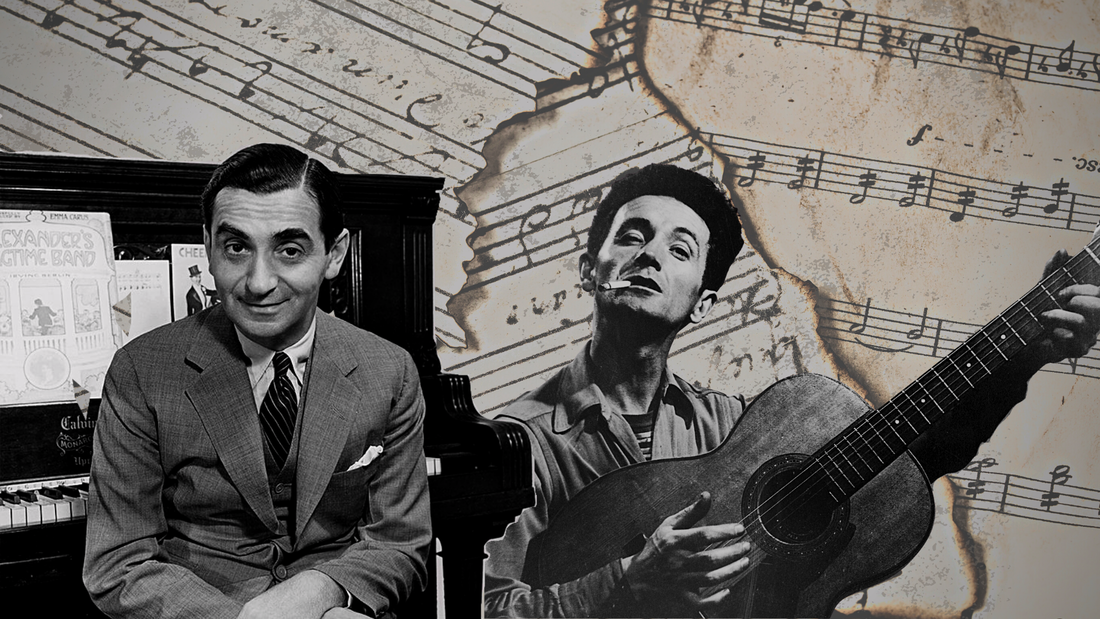|
Read the full story ⬇︎
There’s something blatantly arrogant about the song “Anything You Can Do I Can Do Better,” because it can never be universally true. Everyone has their strengths and everyone has their weaknesses.
But of course, sometimes it is true. Sometimes. And if anyone could be so bold as to attempt such a claim, it was certainly Woody. And you could hardly blame him. Everywhere he turned he couldn't get away from that song (that sappy, blindly patriotic song cut off from the reality of a nation in the wake of the Great Depression). I’m of course talking about Irving Berlin’s hit song “God Bless America.” By February of 1940, Woody had enough of it and decided to fight music with music by writing the words to a song that would capture the hearts of a nation: “This Land is Your Land.”
Creative Inspiration
If you’re looking for it, creative inspiration can come from anywhere, and for Woody Guthrie he found it in trying to beat Irving Berlin at his own game—and in so doing, created a song that has become an anthem of the American spirit.[1] As for Irving Berlin, his muse came in the form of gratitude for a nation that allowed a Russian immigrant raised in poverty to rise up and become one of the most successful songwriters of all time. “To me, ‘God Bless America' was not just a song but an expression of my feeling toward the country to which I owe what I have and what I am.” — Irving Berlin [2] And he is certainly a success story. During his career, Irving wrote over 1,500 songs and by the time he was just 30 years old he had already become a legend, compelling composer George Gershwin to hail him as “the greatest songwriter that has ever lived.”[3] This is no mere hyperbole. After all, we all know his songs—songs like “Blue Skies,” “Cheek to Cheek,” “I've Got My Love to Keep Me Warm,” “There's No Business Like Show Business,” and “Puttin' on the Ritz.” And even though he died more than three decades ago, one of his songs still holds the record for the best-selling single of all time: “White Christmas.”[4] This success certainly adds perspective to just how bold Woody was to suggest “Anything You Can Do, I Can Do Better.” Heck, even that is in Irving’s portfolio—a song he wrote in only a matter of hours for the musical Annie Get Your Gun.[5]
Finding Your Muse
With such an impressive portfolio of creative work, the natural question is how? How did Irving Berlin succeed in creating so much in his lifetime? This is a compelling question— not just for songwriters, but for anyone involved in creative work. Whether you’re a teacher creating lesson plans, a salesperson creating pitches, a storyteller creating stories, a family creating a home, or a creator of truly any kind, being able to find and harness your muse is an essential element of success. What follows are snapshots of Irving Berlin’s creative life that may offer insight for finding your muse: 1. Reduce the Cognitive Load Irving composed all of his songs in the key of F# so he could stay on the black keys of the keyboard, a strategy that was as practical as much as it was functional.[6] He wasn’t a skilled piano player, so reducing the cognitive load helped him to maintain focus on creating. Reflection: How might you promote creativity by reducing the cognitive load? 2. Focus on Simplicity The composer Garrison Hintz once commented that though Irving’s hit “White Christmas” only contains eight sentences, he was able to communicate all that was necessary to capture the hearts of his audience.[7] Reflection: How might you promote creativity through simplicity? 3. Create Something Every Day Irving didn't believe in inspiration; rather, he believed his successful compositions were the result of simply doing the work every day—and sweating blood if necessary.[8] In fact, Saul Bornstein, Irving's Publishing Manager, said "It was a ritual for Berlin to write a complete song, words and music, every day.” [9] Reflection: What might you do to create something every day? 4. Know Your Audience The music critic Stephen Holden notes how Irving’s lyrics flowed “straight out of the rhythms and inflections of everyday speech,”[10] and the music historian Gary Giddins suggests this lyrical style made him an obsessive “commentator on the passing scene.”[11] Irving knew his audience, he spoke their language, and he created songs that spoke to what mattered to them. Reflection: How well do you know your audience? And how are you speaking to them? 5. Sharpen Your Skills, Maintain Your Edge For a time, Irving considered formally studying music composition, and when his friend and fellow composer, Victor Herbert, heard this, he advised: “You have a natural gift for words and music. Learning theory might help you a little, but it could cramp your style.” Irving took this advice and never lost sight of his vision.[12] Reflection: How might you sharpen your creative skills while still maintaining your edge? 6. Turn Pain Into Passion In February of 1912, Irving married Dorothy Goetz, and during their honeymoon in Havana, Dorothy contracted typhoid fever and died six months later. The ensuing grief left Irving with writer's block and he wondered whether he could ever write again. Months later, he returned to songwriting to express his grief and the result was “When I Lost You,” his first ballad, and it was an immediate hit selling more than a million copies.[13] Reflection: How might you use your creativity to turn pain into passion?
Final Thoughts
There’s something beautifully poetic about Lady Gaga’s 2017 Super Bowl halftime show performance, where she elegantly blended “God Bless America” with “This Land is your Land”—a stunt that likely would have inspired Woody to write another song in protest. Aside from the call for unity in the midst of a divided nation, what I most appreciate about this performance was how Gaga created something new from songs written over a half a century ago—holding up a mirror for the composers, their sentiments, and their audience to see themselves reflected. If you’re looking for it, creative inspiration can come from anywhere—and for Lady Gaga, she found it in Irving and Woody. What’s your muse? Want More? Hashtag Positivity helps leaders and their influencers experience joy. Schedule a strategy session with me today to discuss your challenges, goals, and obstacles. References [1] Peithman, S. (2014, July 4). “America’s five national anthems.” Capradio. www.capradio.org/music/classical/2014/07/04/americas-five-national-anthems-1/ [2] Galewitz, H. (2001). Music: A Book of Quotations. Courier Dover Publications. p. 4 [3] Wyatt, R. & Johnson, J.A. (2004). The George Gershwin Reader. Oxford University Press. [4] “Best-selling single.” Guinness World Records. [5] Holden, S. (1995, January 20). “Books of the Times: Recalling the somber man behind so many happy songs.” The New York Times. www.nytimes.com/1995/01/20/books/books-of-the-times-recalling-the-somber-man-behind-so-many-happy-songs.html [6] Adams, C. (2006, July 28). “If Irving Berlin couldn't read or write music, how did he compose?” The Straight Dope. www.straightdope.com/21343780/if-irving-berlin-couldn-t-read-or-write-music-how-did-he-compose [7] (1989, December). “Tribute to Irving Berlin.” Ascap Magazine. [8] Wilder, A. (1972). “American popular song: The great innovators, 1900–1950, Oxford University Press. [9] Holden, S. (1995, January 20). “Books of the Times: Recalling the somber man behind so many happy songs.” The New York Times. www.nytimes.com/1995/01/20/books/books-of-the-times-recalling-the-somber-man-behind-so-many-happy-songs.html [10] Holden, S. (1987, May 10). “Pop View; Irving Berlin's American Landscape.” The New York Times. www.nytimes.com/1987/05/10/arts/pop-view-irving-berlin-s-american-landscape.html [11] Giddins, G (2004). Weather bird: Jazz at the dawn of its second century. Oxford University Press. [12] Berger, M. (1989, September 23). “Irving Berlin, nation's songwriter, dies.” The New York Times. [13] Ibid.
0 Comments
Leave a Reply. |
AuthorJonas Cain, M.Ed. is a storyteller, magician, musician, and facilitator of fascination on a mission to help you experience abiding joy. Topics
All
SubscribeArchives
July 2024
|

















 RSS Feed
RSS Feed
